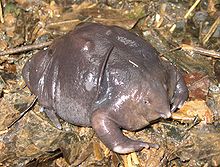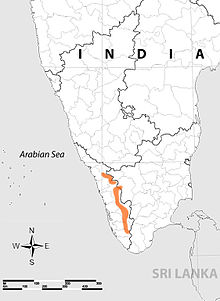Purple frog
| Purple frog | |
|---|---|
 |
|
| Nasikabatrachus sahyadrensis | |
| Calls of Nasikabatrachus sahyadrensis | |
| Scientific classification | |
| Kingdom: | Animalia |
| Phylum: | Chordata |
| Class: | Amphibia |
| Order: | Anura |
| Family: | Sooglossidae |
| Genus: |
Nasikabatrachus Biju & Bossuyt, 2003 |
| Species: | N. sahyadrensis |
| Binomial name | |
|
Nasikabatrachus sahyadrensis Biju & Bossuyt, 2003 |
|
 |
|
| Distribution range of Nasikabatrachus (in ORANGE) | |
Nasikabatrachus sahyadrensis is a frog species belonging to the family Sooglossidae. It can be found in the Western Ghats in India. Names in English that have been used for this species are purple frog, Indian purple frog, or pignose frog. Although the adult frog was formally described in October 2003, the taxon was recognized much earlier by its tadpole, which had been described in 1918. With its closest relatives in the Seychelles, Nasikabatrachus is thought to have evolved separately for millions of years. Its discovery also adds to the evidence that Madagascar and the Seychelles separated from the Indian landmass sometime well after the breakup of Gondwana had started.
The species was described from specimens collected in the Idukki district of Kerala by S.D. Biju from the Tropical Botanic Garden and Research Institute in Palode, India, and Franky Bossuyt from the Vrije Universiteit Brussel (Free University of Brussels), in 2003. However, it was already well known to the local people and several earlier documented specimens and publications had been ignored by the authors in the 2003 paper that describes the genus and species.
The body of Nasikabatrachus sahyadrensis appears robust and bloated and is relatively rounded compared to other more dorsoventrally flattened frogs. Its arms and legs splay out in the standard anuran body form. Compared to other frogs, N. sahyadrensis has a small head and an unusual, pointed snout. Adults are typically dark purplish-grey in color. Males are about a third of the length of females. The specimen with which the species was originally described was 7.0 cm long from the tip of the snout to the vent. Tadpoles of the species had been described in 1917 by Nelson Annandale and C. R. Narayan Rao as having oral suckers that allowed them to live in torrential streams. Suckers are also present in rheophilic fishes of genera such as Glyptothorax, Travancoria, Homaloptera, and Bhavania, adaptations that are the result of convergent evolution. Some of these fishes co-occur with Nasikabatrachus tadpoles in the hill streams. Its vocalization is a drawn-out harsh call that sounds similar to a chicken clucking.
...
Wikipedia

